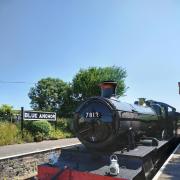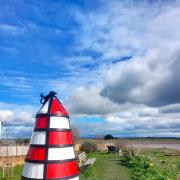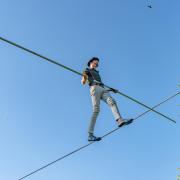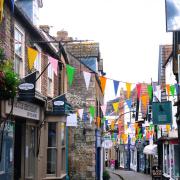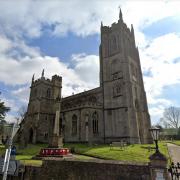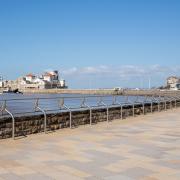Exmoor’s Dunkery Beacon is the highest point in Somerset. So where better to head to on a cycling adventure in search of unparalleled views, writes Laurence McJannet.

I have been exploring Somerset by bike for some 15 years now, but having lived all that time on the county’s western fringe, near the Wiltshire border, until recently I still had yet to ride to its most prominent feature. At 520m (1,705ft) Dunkery Beacon is not only the highest point on Exmoor and the entire county of Somerset but also the whole of the south of England outside Dartmoor. It is said that from the Bronze Age barrow at its summit you can see Welsh hills that lie well over 100km away. So what was I waiting for?
I remembered some years before I had stopped off at a wonderful pub in Monksilver, and a quick online search revealed it was still there and more popular than ever, so I devised an off-road cycle route that would allow me time to make a leisurely two-day trip to Dunkery Beacon, staying overnight at the Notley Arms on Exmoor’s eastern edge before seeking out these famous views. To add to that feeling of adventure I decided to travel by steam train too – taking the West Somerset Railway from Bishops Lydeard, its easterly terminus in the Quantock valley, to Blue Anchor on the coast, planning to finish at its westerly terminus, Minehead, the following day to head home.

Waiting for late winter to show faint signs of spring may not seem like the ideal time for a two-day cross-country cycle ride but the skies were a clear albeit weak blue and the air mild as I left the wheezing steam locomotive behind at the Blue Anchor stop. With Dunster Beach and Blue Anchor Bay stretching out behind me I took the road south to the village of Carhampton then out into the eastern fringe of Exmoor. As expected, as soon as I crossed the boundary into the National Park I began climbing, first on a rough old road some 200m up Withycombe Hill, then without respite another 150m on a rougher track to the top of Black Hill. The reward for my effort was fine views of the expanse of north Somerset coastline unfolding behind me, which I dwelt on as I caught my breath before a fantastic freewheel descent to the wooded valley through which flowed Washford River. From here my progress was unhindered by further gradient as the last leg of my day’s journey took me south west through another valley (or ‘combe’ in these parts) to the wonderful Notley Arms in the quiet village of Monksilver. With robust food and smart, spacious rooms (mine was a fantastic superior king-size, with walk-in shower, for just £74 for the night), it was better than I remembered – in fact I felt my day’s efforts hardly warranted such luxury. I’d only travelled 17km but, after chatting to a friendly crowd at the bar, retired contented to my room, sleeping soundly and deeply.
Setting off after a hearty breakfast to head deeper into the moor, there was a noticeable chill in the air, and a fine mist hanging in the valley as I continued along the bank of the Washford River. The trail beneath my wheels was firm gravel as far as Roadwater, but soon became a rough mulch of wet leaf litter and tree bark as I left the south bank behind and began to climb amongst thick conifers. The excursion was pleasantly warming, however, and I felt revitalised as I emerged from the trees near Luxborough, onto country roads again, amid a patchwork of rolling arable land. Soon, and without realising, I had climbed Lype Hill, just 100m shy of the summit of Dunkery Hill, which rose now to the north west, a beacon in both literal and metaphorical terms. From Wheddon Cross the tracks became rougher in parts, squelchier in others, as manicured farmland gave way to the wilder moors. My trail left the wooded comfort of Mansley Combe to climb its northern bank and for a while the unyielding gradient and loose stoney ground made my progress painfully slow. Yet my beacon beckoned me on, and as the wind began to whip across the moor I completed my ascent and slumped, exhausted but satisfied, at the pinnacle of my home county. I had the beacon, and the whole of Somerset it seemed, to myself.

It was a while before I could take in the views but they have stayed with me ever since. Even under an unremarkable winter sky the panorama before me was anything but. To the south Dartmoor’s peaks stood out starkly against the clouds; to the north, beyond a glorious expanse of coastline, it must have been the Brecon Beacons whose hazy silhouettes seemed to shift beneath the clouds. I would have loved to linger but the wind had begin to cut through me and I still had a way to go. However my journey home was an easy one. And from the highest point for miles, surely the only way is down? Surveying the scene one last time I remounted my bike and dropped off the Beacon, cautiously feathering my brakes. Although the initial descent along the Macmillan Way West was technical, it soon gave way to wider trails. And while there looked to be some enjoyable riding to be found on the myriad trails on Dunster Hill, I had rightly predicted how tired I would be by now so opted for flat metalled lanes that skirted the foothills at Tivington. Some climbing was unavoidable so close to another of Somerset’s high points – Selworthy Beacon – but after traversing the main road gentler slopes meant I could take the final leg of my journey, to a waiting steam engine at Minehead’s heritage railway station, at something of a canter. In a comfortable carriage on my journey home I felt inspired to have been the highest person in the county, if only briefly, and resolved to return to Dunkery Beacon in fairer weather and under clearer, bluer skies, to really commit that glorious view to memory.
Laurence McJannet is the author of Bikepacking – Mountain Bike Camping Adventures on the Wild Trails of Britain, available from wildthingspublishing.com.
Getting there...
This journey is easily done without a car, and is all the more satisfying if using the heritage West Somerset Railway.
The terminus at Minehead is the closest station to Dunkery Beacon, though Dunkery and Blue Anchor stations offer interesting routes to the summit. There is plenty of space for bicycles on board, but these must be booked ahead. of time. The WSR timetable varies depending on the season. Check west-somerset-railway.co.uk before you travel.




